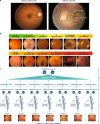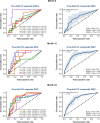Deep learning algorithm predicts diabetic retinopathy progression in individual patients
- PMID: 31552296
- PMCID: PMC6754451
- DOI: 10.1038/s41746-019-0172-3
Deep learning algorithm predicts diabetic retinopathy progression in individual patients
Erratum in
-
Author Correction: Deep learning algorithm predicts diabetic retinopathy progression in individual patients.NPJ Digit Med. 2020 Dec 8;3(1):160. doi: 10.1038/s41746-020-00365-5. NPJ Digit Med. 2020. PMID: 33293570 Free PMC article.
Abstract
The global burden of diabetic retinopathy (DR) continues to worsen and DR remains a leading cause of vision loss worldwide. Here, we describe an algorithm to predict DR progression by means of deep learning (DL), using as input color fundus photographs (CFPs) acquired at a single visit from a patient with DR. The proposed DL models were designed to predict future DR progression, defined as 2-step worsening on the Early Treatment Diabetic Retinopathy Diabetic Retinopathy Severity Scale, and were trained against DR severity scores assessed after 6, 12, and 24 months from the baseline visit by masked, well-trained, human reading center graders. The performance of one of these models (prediction at month 12) resulted in an area under the curve equal to 0.79. Interestingly, our results highlight the importance of the predictive signal located in the peripheral retinal fields, not routinely collected for DR assessments, and the importance of microvascular abnormalities. Our findings show the feasibility of predicting future DR progression by leveraging CFPs of a patient acquired at a single visit. Upon further development on larger and more diverse datasets, such an algorithm could enable early diagnosis and referral to a retina specialist for more frequent monitoring and even consideration of early intervention. Moreover, it could also improve patient recruitment for clinical trials targeting DR.
Keywords: Macular degeneration; Predictive markers; Vision disorders.
Conflict of interest statement
Competing interestsF.A., F.B., M.P., and A.M. are employees and shareholders of Roche, Inc. J.W. and Z.H. are employees and shareholders of Genentech, Inc.
Figures




References
-
- International Diabetes Federation. IDF diabetes atlas: 8th edn. http://www.diabetesatlas.org/ (2017).
-
- Brar, M. & Ho, A. C. Diabetic eye disease: a multidisciplinary discussion on managing diabetic eye disease. EyeNet Magazine Suppl. 1–4 (2016).
LinkOut - more resources
Full Text Sources
Other Literature Sources

